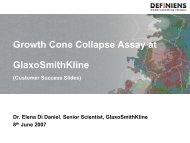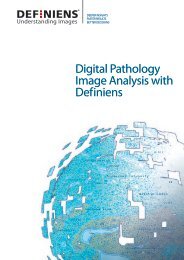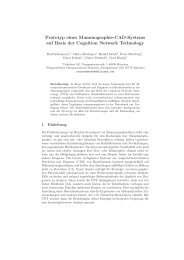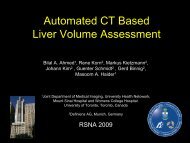Definiens in Medical Imaging
Definiens in Medical Imaging
Definiens in Medical Imaging
Create successful ePaper yourself
Turn your PDF publications into a flip-book with our unique Google optimized e-Paper software.
2<br />
The Challenge <strong>in</strong><br />
<strong>Medical</strong> Imag<strong>in</strong>g<br />
<strong>Medical</strong> imag<strong>in</strong>g helps to detect, identify and observe tumors<br />
over time. Screen<strong>in</strong>g, for example, is the first l<strong>in</strong>e of defense<br />
aga<strong>in</strong>st breast cancer. CT and MRI scans are vital diagnostic<br />
tools. Biopsies help to determ<strong>in</strong>e whether lesions are malig-<br />
nant or benign. And, once treatment has begun, medical<br />
imag<strong>in</strong>g is one of the most powerful tools for measur<strong>in</strong>g<br />
therapeutic response.<br />
The proliferation of image data <strong>in</strong> oncology has created some major challenges.<br />
First and foremost, there is a global shortage of tra<strong>in</strong>ed radiologists and histopathologists.<br />
Without them, the <strong>in</strong>creas<strong>in</strong>g number of scans and tissue samples cannot<br />
be analyzed, creat<strong>in</strong>g an ‘image analysis bottleneck’ that delays the diagnosis and<br />
treatment of patients.<br />
Secondly, the task is very complex. Due to the <strong>in</strong>herent variability of liv<strong>in</strong>g organisms,<br />
even the most detailed scans can be difficult to <strong>in</strong>terpret. As we strive to detect a<br />
cancer ever earlier, many tumors are so small and escape easy detection. The Journal<br />
for Thoracic Imag<strong>in</strong>g noted, <strong>in</strong> a study evaluat<strong>in</strong>g the detection of small pulmonary<br />
nodules, that: “Observer detection of pulmonary nodules <strong>in</strong> the range of 5-15mm<br />
us<strong>in</strong>g current digital radiography systems is not reliable <strong>in</strong> the confus<strong>in</strong>g environment<br />
of the lung.” 1<br />
Spott<strong>in</strong>g lesions and tumors requires concentration, tra<strong>in</strong><strong>in</strong>g and a very good eye. In<br />
this challeng<strong>in</strong>g <strong>in</strong>terpretive environment, human error is compounded by fatigue<br />
and an overload of data.<br />
Taken together, these challenges delay detection, diagnosis and treatment.This causes<br />
unnecessary patient suffer<strong>in</strong>g and results <strong>in</strong> more costly and less effective treatment.<br />
Screen<strong>in</strong>g Diagnostic Stag<strong>in</strong>g Therapy Follow-up<br />
e.g. Mammography e.g. CT Colonoscopy e.g. Mammography e.g. CT Colonoscopy e.g. Whole Body MR<br />
Figure 1 Patient diagnostic and treatment paradigm<br />
Early diagnosis starts with screen<strong>in</strong>g, followed by diagnostic tests if suspicious lesions are found. In the case of malignant<br />
f<strong>in</strong>d<strong>in</strong>gs the stag<strong>in</strong>g phase will be used to size and locate tumors which may be treated with surgical, chemical or radiation<br />
therapy or a comb<strong>in</strong>ation. Follow<strong>in</strong>g the treatment a “re-stag<strong>in</strong>g” evaluates the success of therapy.<br />
<strong>Def<strong>in</strong>iens</strong> <strong>in</strong> <strong>Medical</strong> Imag<strong>in</strong>g<br />
1 Wu, N, et al.Vol. 21 (1): pp27-31. March 2006. Available at: www.ncbi.nlm.nih.gov/pubmed/16538152.










